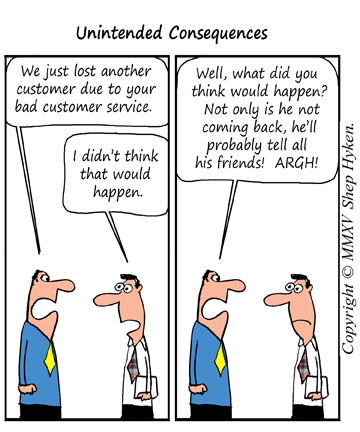 Someone in your organization irritated your customer. The customer left angry or upset. Maybe the customer was less than friendly and was difficult. Maybe the customer was too demanding or had unrealistic expectations. Whatever the reason, it doesn’t matter. The customer left unhappy.
Someone in your organization irritated your customer. The customer left angry or upset. Maybe the customer was less than friendly and was difficult. Maybe the customer was too demanding or had unrealistic expectations. Whatever the reason, it doesn’t matter. The customer left unhappy.
Someone might say, “Well, it was just one customer.” Well that way of thinking is so last century!
First, do you really want to lose a customer? And, if you did, is just one customer an acceptable loss? But it hardly ever turns out that way. It used to be, depending on what statistics you looked at, that the average customer who was unhappy might tell eight to twelve people about the negative experience. That’s bad news, but there is even worse news. 13% of unhappy customers would tell 20 or more. Now, maybe you can afford to lose one customer, although I’ll argue that you really shouldn’t think that way. But, are you willing to part with the eight or more customers that may stop doing business or choose not to try you because of one customer’s amplified message of dissatisfaction? I don’t think so.
However, as I mentioned, this is so last century. It was in the year 2000 that Trip Advisor began serving up travel related content and reviews on the Internet. Not that many years later, in 2004, Yelp was born. These were early forms of social media. In the past three to five years the concept of socializing reviews of companies, their products and their services, has become common. Which leads us to the concept of unintended consequences.
The stats on complaining customers just mentioned are no longer valid. With Twitter, Facebook and other social media sites, the customer’s voice is louder than ever. Customers turn to the social channels to broadcast their likes and, unfortunately, their dislikes to their connections. Ultimately, that could be millions of people. The unintended consequence of not managing your customer’s experience can turn into much more than one or even a few lost customers.
So, consider this a reminder or a wake-up call to manage each and every customer as if they will publically review you. One simple technique is to ask yourself one of my favorite questions, which ties into building repeat business:
Is the interaction that I’m having with the customer right now good enough get the customer to come back and do business with us the next time they need what we do or sell?
If the answer is YES, then you don’t have to worry about any negative unintended consequences.
This article was syndicated from Business 2 Community: Unintended Consequences: The Fallout from Bad Customer Service
More Sales & Marketing articles from Business 2 Community:




